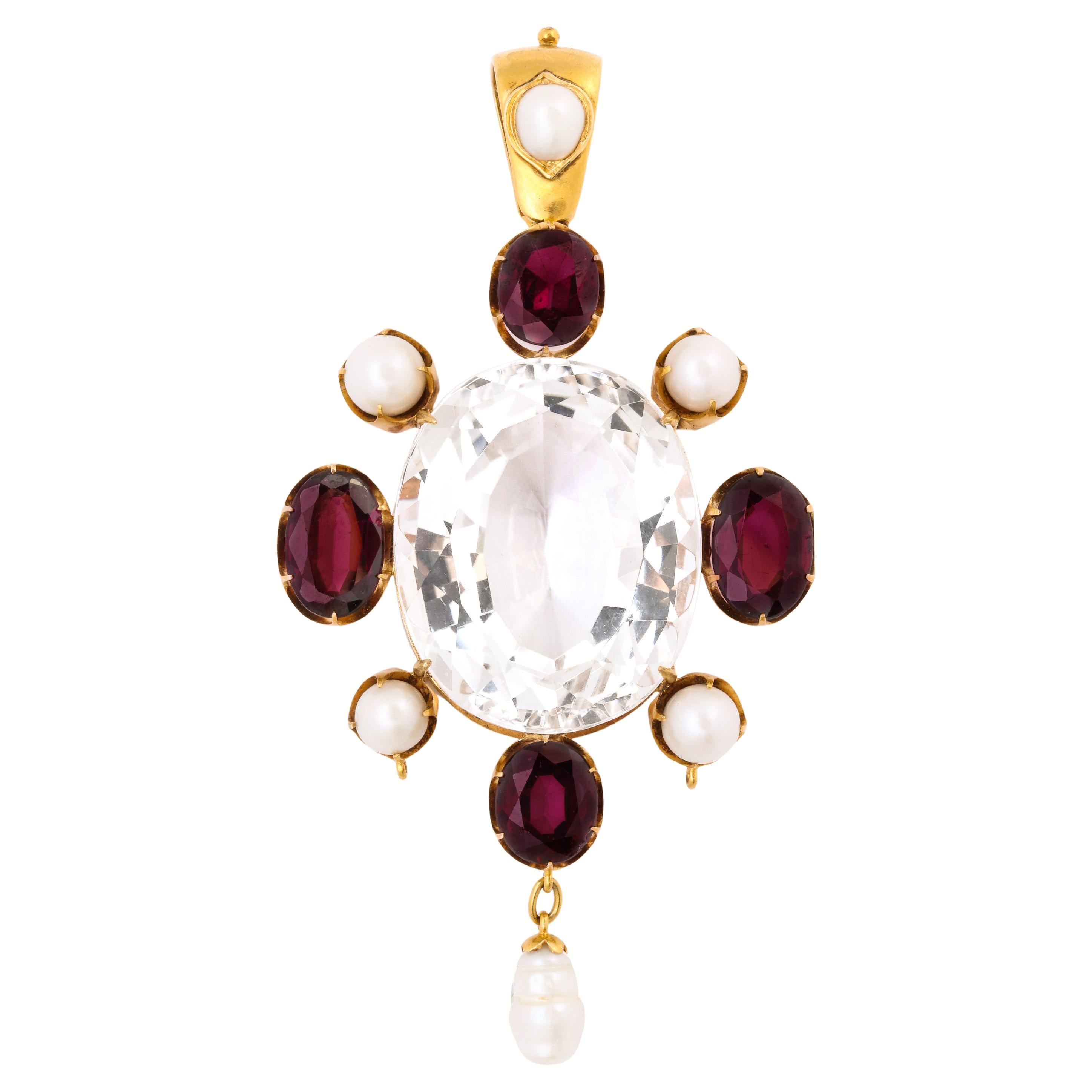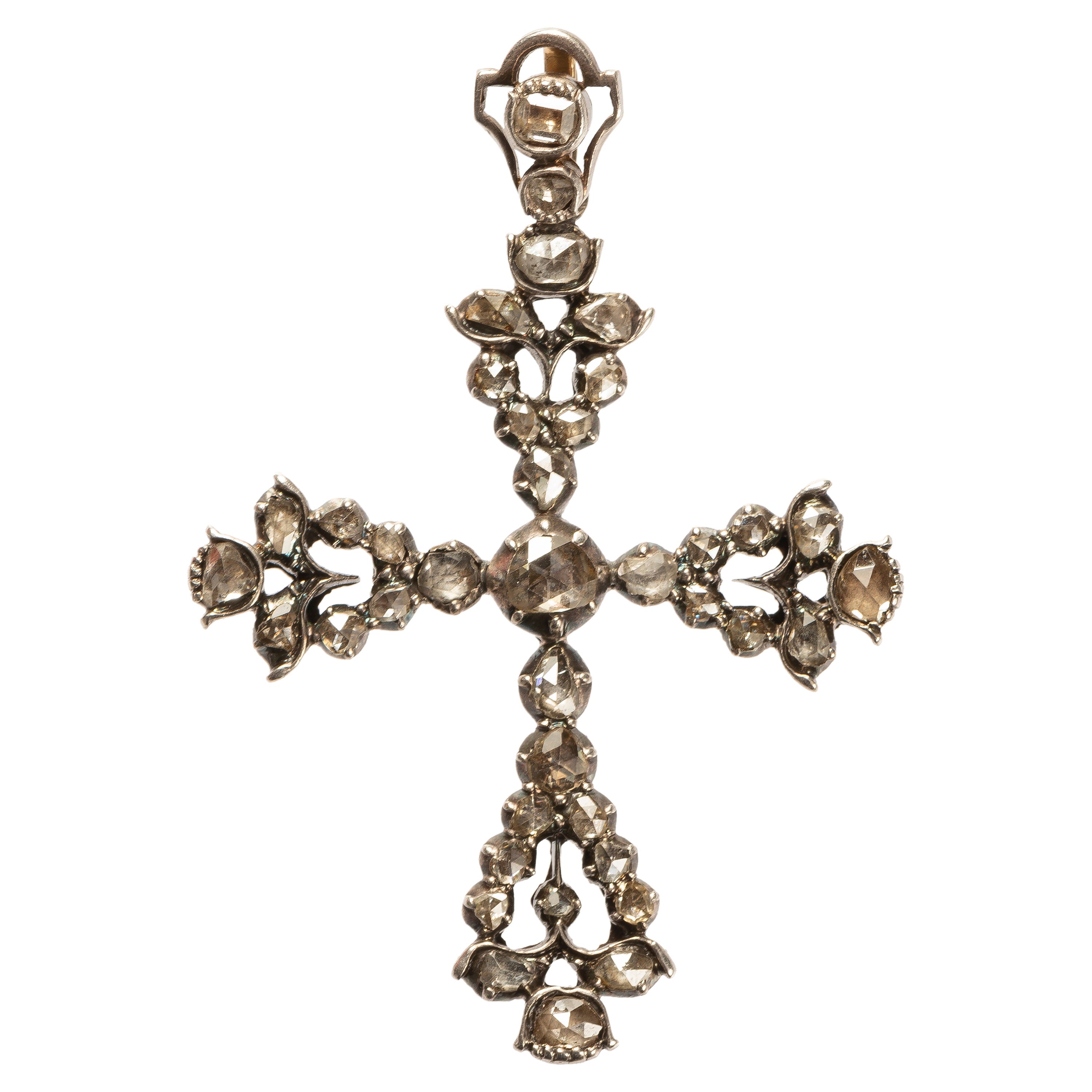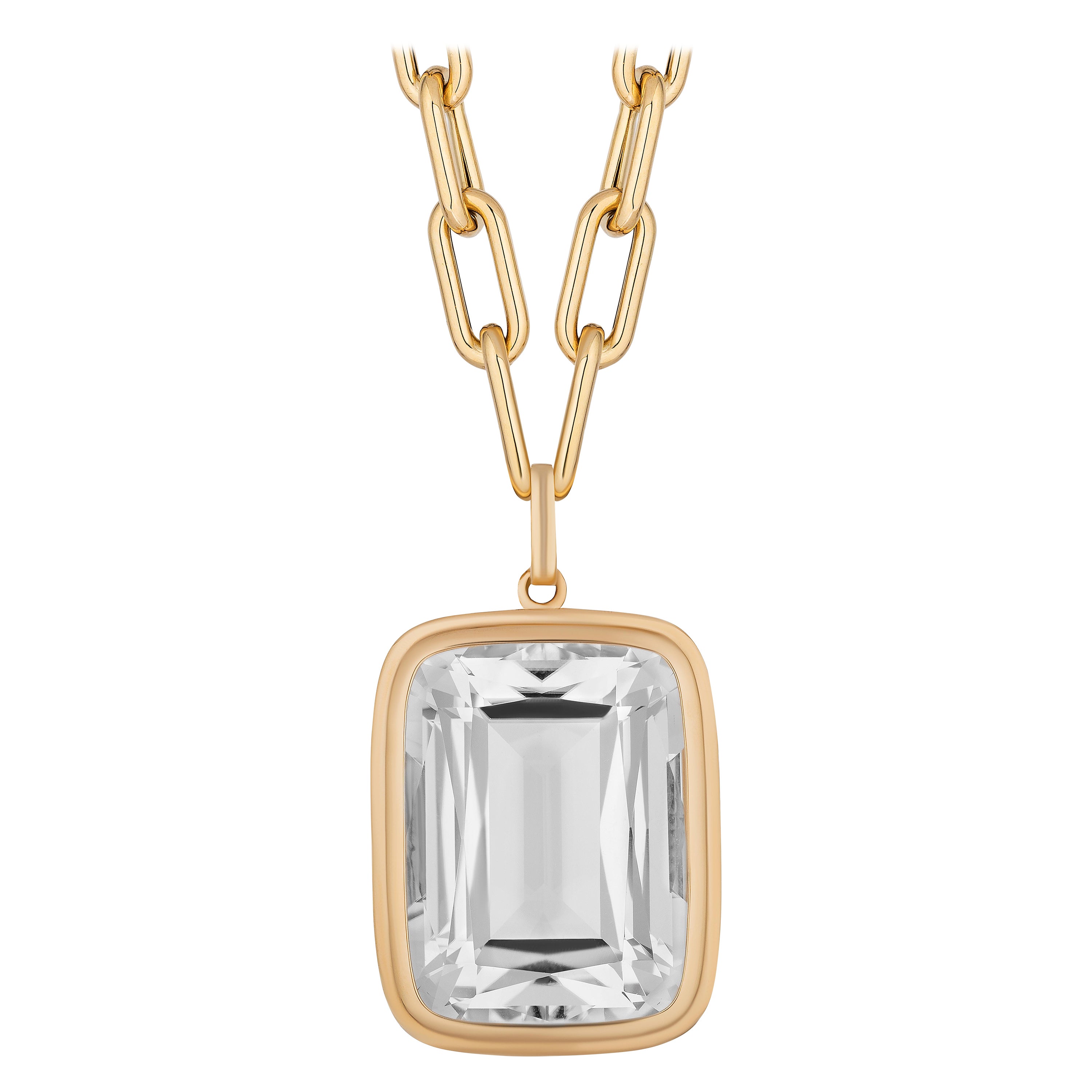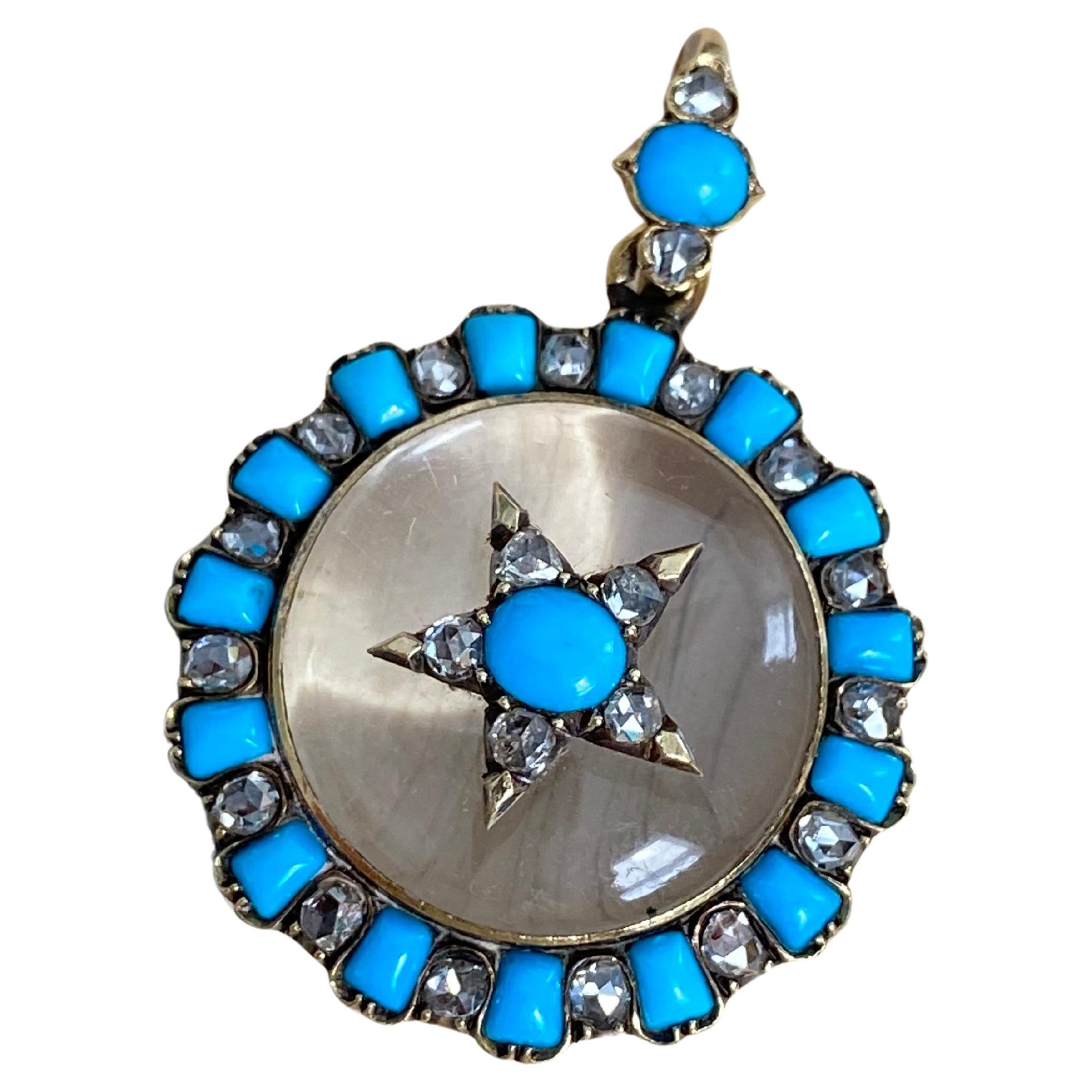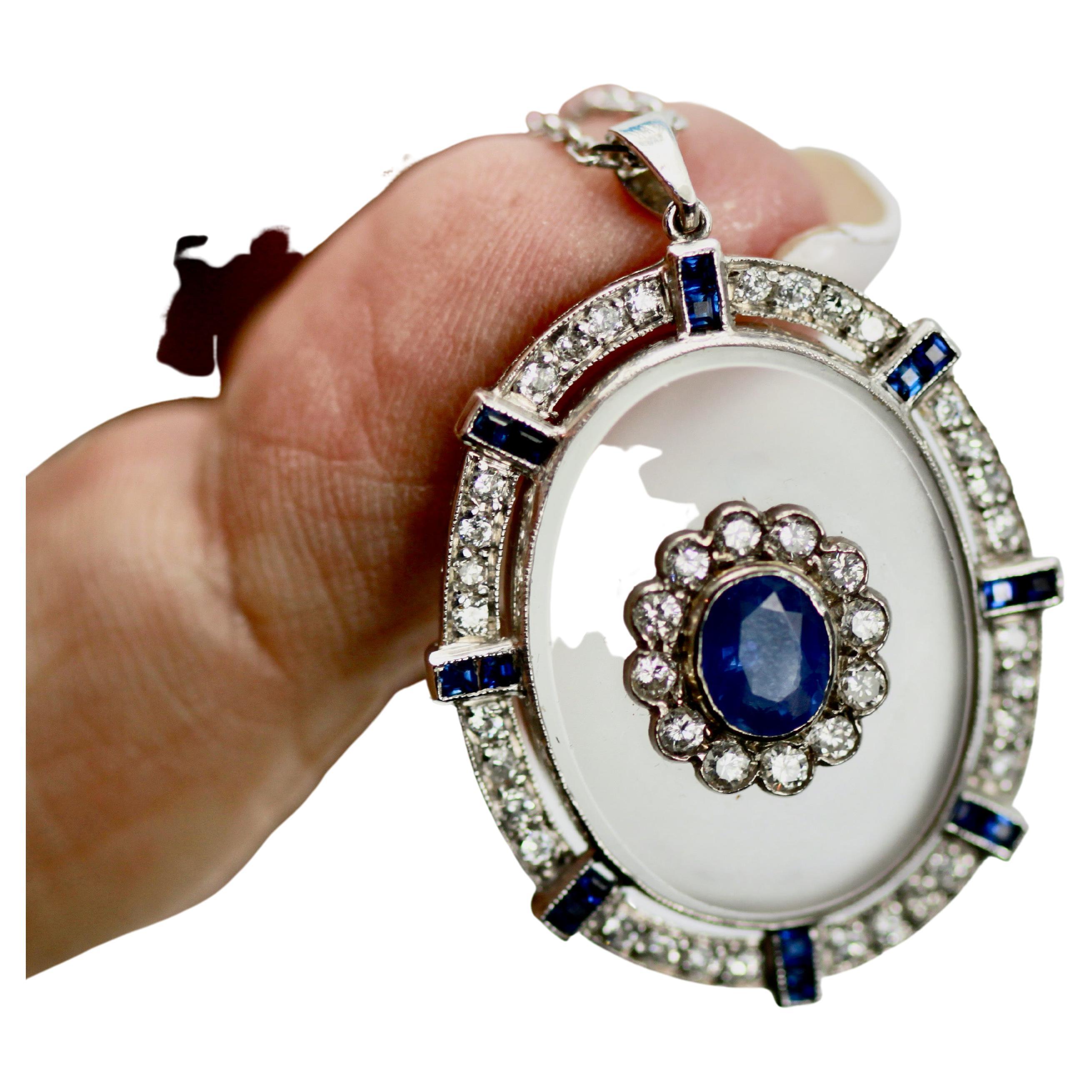Items Similar to Antique Architectural Rock Crystal Pendant
Video Loading
Want more images or videos?
Request additional images or videos from the seller
1 of 6
Antique Architectural Rock Crystal Pendant
About the Item
ROCK CRYSTAL PENDANT WITH COLUMN
France or Italy, 16th century
Fire-gilded silver, rock crystal, verre églomisé
Weight 96 grams; dimensions 75 × 35 × 21 mm (with loop)
Architectural pendant with rectangular cross section, rock crystal casing, and gilded silver mounts forming the base and roof, both profiled and on the sides connected by a hinge mechanism. Inside is a crystal column with verre églomisé. Above and below the mounts appear an engraved four-petaled flower against a lined background; on top, a baluster-shaped base for pendant loop and ring; along the edges, the initials F B/G L [o]; and below, M G/F C and finial.
This is a wonderful object for “crystal gazing.” Although it has suffered minor fracturing—a hazard to which this gem is prone (Pliny recounted a few horror stories)—this large piece of rock crystal is very clear and therefore of exceptional quality for its era. The substantial gem, which is an extremely valuable and powerful substance, here seems to proclaim itself as a material presence even more than a means of protection for the contents of the tiny cylinder at its core. One was to experience the crystal as crystal.
The large gem rests in a substantial gilded silver setting with what can only be called architectural elements. A series of moldings at both top and bottom create a cornice and socle of sorts that define the piece as a monument in miniature, a tiny temple. Again the purpose seems to be to capture the gaze, control it, and direct the eye to what is held at the center of the piece.
At that center is a void, a cylinder drilled out of the gem. Dropped into this space is a tiny gilded column with a few apertures marked out with ogee arches. What was originally in these spaces is unclear from visual inspection—were there relics? Paintings? The later history of this piece and its wear have frustrated its very purpose—to display its sacred contents.
One might compare the effect with another architectural reliquary from Spain, which similarly has a central columnar element and a surrounding rock crystal (although much smaller and less substantial), and again, a setting with architectural elements. However in the pendant from the Hispanic Society, the relics are labeled and contained in the base and “abacus” of the column. The elaborate enameled ornamentation to some degree draws attention away from the rock crystal core.
The top and bottom of this reliquary further contribute to the mystery. Here we find a floriated incised decoration and, inside an outer frame, a series of letters, probably the owner’s initials but thus far unidentified (F B/G Lo and M G/F C).
Provenance: Collection of Thomas F. Flannery Jr. (1926-1980), a Chicago neon-sign producer and a collector of medieval and later works of art; his sale, London, Sotheby’s, 1 December 1983, lot 276.
Comparisons and Literature: The pendant is unique in design, and the column in the center probably represents a relic from a place of pilgrimage. In the Basilica of St. Maximin in La Sainte Baume (southern France), the relics of Mary Magdalene have been venerated since 1279, when her bones were discovered in a sarcophagus. Charles Salerno, nephew of St. Louis of France, who became Count of Provence and King of Sicily under the name Charles II, founded the Basilica. Mary Magdalene’s relics are encased in a life-size reliquary with her skull held by saints; below is a tabernacle with column and painted motifs similar to the column in the pendant (Jansen 2000, pp. 221-22; 247- 49). In the crypt where Mary Magdalene’s sarcophagus is kept, there are three more sarcophagi that are thought to contain relics of saints. The significance of the initials engraved on the pendant remains unknown. For a columnar pendant with relics of saints, cf. a Spanish example in the Hispanic Society of America, New York (Muller 2012, p. 78, fig. 118).
- Metal:
- Stone:
- Stone Cut:
- Weight:96 g
- Dimensions:Height: 2.76 in (70 mm)Width: 2.96 in (75 mm)Depth: 0.83 in (21 mm)Length: 1.38 in (35 mm)
- Style:
- Period:
- Date of Manufacture:16th century
- Condition:Wear consistent with age and use.
- Seller Location:Chicago, IL
- Reference Number:
About the Seller
5.0
Vetted Seller
These experienced sellers undergo a comprehensive evaluation by our team of in-house experts.
Established in 1991
1stDibs seller since 2021
5 sales on 1stDibs
Typical response time: 13 hours
- ShippingRetrieving quote...Ships From: Chicago, IL
- Return PolicyA return for this item may be initiated within 3 days of delivery.
More From This SellerView All
- Antique Silver Spanish Cross Pendant with Rock CrystalsLocated in Chicago, ILCross Pendant with Rock Crystals Spain or Portugal, late 17th - early 18th century Silver, gold, rock crystal Weight 9.1 gr.; Dimensions 56.3 × 38.8 mm. An elaborate and elegant cross pendant made of silver with rock crystals in closed settings. The center consists of a larger round gemstone surrounded by five irregular-shaped stones forming the cross. The openwork arms have a triangular shape and are formed of facetted rock-crystals in foliate settings. The obverse side of the cross consists of a layer of gold. An extension with two stones and an angular shaped frame is hooked into the pendant loop, probably to be worn on a velvet band. The pendant is in good, wearable condition. After the Reformation, cross pendants were worn mainly in Catholic countries by men, women, and children. During the seventeenth century, the designs became ever more intricate, and the crosses were often embellished with gemstones, such as rock crystals in this example. These were sourced along the Alpine regions of France, Switzerland, Austria, and Southern Germany. The stones gave the appearance of diamonds. The foliate settings are characteristic of late seventeenth- and eighteenth-century jewelry made in Spain...Category
Antique Late 17th Century Pendant Necklaces
MaterialsCrystal, Rock Crystal, Gold, Gold Plate, Silver
- Antique Reliquary Book Pendant LocketLocated in Chicago, ILRELIQUARY PENDANT IN BOOK FORM Probably southern Germany, 1630–40 Gilded silver, verre églomisé Weight 13.2 grams; dimensions 42 × 25 × 12 mm; opens to 40 mm Gilded silver pendant in book form with hinged, lid, corded wire surround, and engraved spine. The front cover of the book is set with a plaque depicting Moses receiving the Law in verre églomisé, and the back cover shows the Sacrifice of Abraham. The scenes are in gold against a red background. When opened, the book reveals two portraits, probably of a husband and wife, wearing seventeenth-century dress. The costumes suggest a date c. 1630-40; the wife holds a daisy. Trefoil-shaped pendant loop on top and bottom, and book clasp. As in the scenario described for the assemblage of these pendant miniature books (see no. 34), this book may have satisfied the desires of a particular patron, perhaps even one of the Jewish faith. The images that have been chosen for the four verre églomisé inserts are somewhat unusual within the group of comparable objects; on the front is Moses, on the back is the Sacrifice of Isaac. On the inside, instead of an iconic or doctrinal image, one sees portraits of the patron and his wife, in their finest dress, contents reminiscent of a modern locket...Category
Antique Mid-17th Century Pendant Necklaces
MaterialsGilt Metal
- Antique Spanish Jet Amulet Pendant with FigaLocated in Chicago, ILAMULET PENDANT WITH FIGA Spain, c. 1620–1630 Jet, silver, and enamel Weight 60.7 grams; dimensions 85 × 49 × 18 mm Large pendant in the shape of a hand carved from jet with a clinched fist in the figa (Spanish higa) gesture. In the palm of the hand is a heart carved in relief and on the back a six-ray star in a circle. The silver mount covers the wrist like a cuff and is decorated with a frilled border, and on the front with collet-set bosses with silver C-scrolls against blue enamel; on the back is a roundel in relief with floral motif. Domed base for the pendant loop in pea-pod form. The figa (also fica or higa) represents an age-old symbol of protection against the evil eye and other demonic threats. Its origins were pagan and buried deep in antiquity. Roman examples, such as one found recently in an archeological excavation in London, also make it clear that the protective qualities are based in a sexual symbolism–particularly the power of the phallus. The Roman bone figa/phallus in effect represents the phallus twice; that is, the gesture made by the figa hand is generally explained as fingers representing the female genitalia (vulva) penetrated by the phallus of the thumb. But other interpretations are less specific, including explanations that the left hand is the feminine principle, and the right hand is the masculine. In Spain, jet figa are common; we see one in the portrait of Anne of Austria the infanta (p. 75). That is not to say that the objects are not sumptuous or treasured. Jet was a very valuable material, and in many examples like this one, the figa is embellished with beautiful enameling or is even gem-studded. Comparable objects occur in equally sumptuous materials such as rock crystal. The enameled setting allows a dating of these objects that otherwise might prove difficult, given that the production of such objects in Spain is so consistent over centuries. Indeed, there is another, even more elaborately carved example in this collection, attached to the “magic belt” (no. 9). That example may belong to an earlier group. That figa includes deeply excavated carving, including on the upper surface, an M-shaped design that Walter Leo Hildburgh links to the heart shape (as it occurs more explicitly on this example). Hildburgh argues that its presence is especially common on these objects and that it originally represented the Sacred Heart of Mary...Category
Antique Early 17th Century Spanish Pendant Necklaces
MaterialsSilver
- Antique Gold Pendant with Diamonds and PearlsLocated in Chicago, ILPendant with Virgin Mary as Queen of Heaven Western Europe, Southern Germany (?), Italy (?), c. 1550-1560 Gold, enamel, diamonds, and pearls Weight 13.2 gr; Length 36.9 x 31.2 mm (incl. pearls) This sumptuous image exudes regal power. It portrays the Virgin Mary as Queen of Heaven wearing a dress and crown studded with seven large diamonds and set against a translucent, rich blue celestial background. Far removed from the tender, humble Virgin seen in German and Netherlandish artworks of the period, she is a majestic ruler, mouth sternly set, head tilted upward, and face in full profile. The oval pendant cast in high gold relief with a central medallion, the single figure filling the space, echoes jewelry portraits of the aristocracy during the Renaissance, which similarly offset the ruler’s image against a blue field composed of enamel or lapis lazuli, symbolic of divine power Only the rays of the shining gold halo that emerge behind the Virgin’s head and her long flowing hair (instead of neatly coiffed) distinguish her from female ruler portraits of the period. Three studded pearls, forming an axis, also recall pendants of European rulers. Wealth, royal status, and divine power come together in this opulent pendant. Portraits of the period show similar small oval pendants worn by women in the square of the garment or by men nestled inside multiple chains below the base of the neck. PROVENANCE European Private Collection LITERATURE Compare images from ancient Rome, for example a sardonyx cameo with female head (Kugel 2000, no. 18; Milan, c. 1550), and a pendant with gold, pearls, and enamel in the Staatliche Museum Kassel (Schmidberger/Richter 2001, no. 43; France, c. 1555-1560). For ruler pendants with blue backgrounds see a pendant of King Frances I...Category
Antique 16th Century Pendant Necklaces
MaterialsDiamond, Pearl, Gold
- Renaissance Gold Marriage Ring with Table-Cut Rock CrystalLocated in Chicago, ILRenaissance Marriage Ring Western Europe, late 16th century Gold, rock crystal, traces of white and black enamel Weight 4.09 g; circumference...Category
Antique 16th Century European Renaissance Solitaire Rings
MaterialsRock Crystal, Gold
- Antique Eastern European Silver Cross PendantLocated in Chicago, ILRELIQUARY CROSS PENDANT Balkans (probably Bulgaria), 18th-19th century Gilded silver, glass pastes Weight 40.7 grams; dimensions 74 × 15 × 10 mm Double-sided pendant made of gilded silver filigree in the shape of a Greek cross, with pendant loop. The front and side panels composed of intricate filigree scrolls, globules, and a central rosette. Interspersed are crimped collet settings with corded wire base and red, blue, and green glass-paste gem...Category
Antique 18th Century More Jewelry
MaterialsSilver, Gilt Metal
You May Also Like
- Antique Victorian Rock Crystal Garnet PendantLocated in Stamford, CTSome like it hot and dramatic which is an accurate description of this large 60ct Victorian Rock Crystal, Garnet and Natural Pearl Pendant. If that is not enough magic, add an original bale, six natural pearls and 11n cts of wine colored garnets. A statement piece indeed that beautifully made and has been cared for for 180 years. A jewel that more than hints and your daring personality and pride in your individuality. The healing properties of crystal are enlightenment and healing of the spirit and promotion of spiritual and physical well being. The word crystal comes from the Greek word krustallos which means ice. It is the sister gem to amethyst and citrine, Perfect condition. 3 1/4 inches high, 1 3/4 inches wide Weight 34 Grams For a Grand Dame...Category
Antique Late 19th Century Victorian Pendant Necklaces
MaterialsCrystal, Natural Pearl, 15k Gold
- Goshwara Rock Crystal Cushion PendantBy GoshwaraLocated in New York, NYRock Crystal Cushion Pendant in 18K Yellow Gold, from "Manhattan" Collection. Minimalist lines yet bold structures is what our Manhattan Collection is all about. Our pieces represent...Category
21st Century and Contemporary Indian Contemporary Pendant Necklaces
MaterialsCrystal, Rock Crystal, 18k Gold, Yellow Gold
- Antique Rock Crystal and Yellow Gold Pendant / BroochLocated in Jesmond, Newcastle Upon TyneA stunning, fine and impressive, rock crystal and 21 karat yellow gold pendant/ brooch; part of our antique jewellery and estate jewelry collections. This stunning antique Victorian pendant/brooch has been crafted in 21k yellow gold. The impressive oval frame is ornamented to the centre with an exceptional rock crystal panel, displaying finely detailed three leaves, accented with floral decoration. This central convex panel is encompassed with a 21k yellow gold frame ornamented with rope twist decorated borders, in addition to an applied scalloped design accented with scrolling and ball motifs. The reverse of the setting is fitted with a push fit glass panel, which allows a personal memento or keepsake to be displayed. This exceptional Victorian rock crystal pendant...Category
Antique 1890s Unknown Pendant Necklaces
MaterialsRock Crystal, Yellow Gold
- Antique 18K Rock Crystal, Turquoise and Diamond Star Locket PendantLocated in Hummelstown, PAFrom the mid-19th century comes this delightful rock crystal locket. Meticulously hand fabricated in 18k gold, the glowing rock crystal cover is overlaid with a bright turquoise and ...Category
Antique 1880s Pendant Necklaces
MaterialsCrystal, Diamond, Rock Crystal, Turquoise, 18k Gold
- Rock Crystal Pendant Sapphire Diamonds 18KLocated in North Hollywood, CAI just love this pendant. This pendant is beautiful with a frosted Rock Crystal base set with a Sapphire with Diamond surround. The crystal is set with Diamonds and Sapphires on a s...Category
2010s American Modern Pendant Necklaces
MaterialsCrystal, Diamond, Rock Crystal, Sapphire, 18k Gold
- Antique Edwardian 18 Kt Serpent Wrapped Rock Crystal PendantLocated in Stamford, CTAn 18 Kt gold serpent set with a turquoise wraps around the top of this icy clear rock crystal prism creating a talisman you will treasure. The crystal is strikingly faceted into an ...Category
Antique Early 1900s English Edwardian Pendant Necklaces
MaterialsRock Crystal, 18k Gold
Recently Viewed
View AllMore Ways To Browse
Medieval Column
Crystal Skull
Crystal Skulls
Italian Eglomise
Antique Tabernacles
Antique Tabernacle
Engraved Bone
Abacus Used
Antique Initial Pendant
Italian Large Antique Columns
Antique Eglomise
Antique Spanish Rings
Antique French Enamel Ring
Antique French Gilded Pendant
Antique Medieval Jewelry
Engraved Initial Pendant
Jewelry Initial F
Antique Metal Letters
